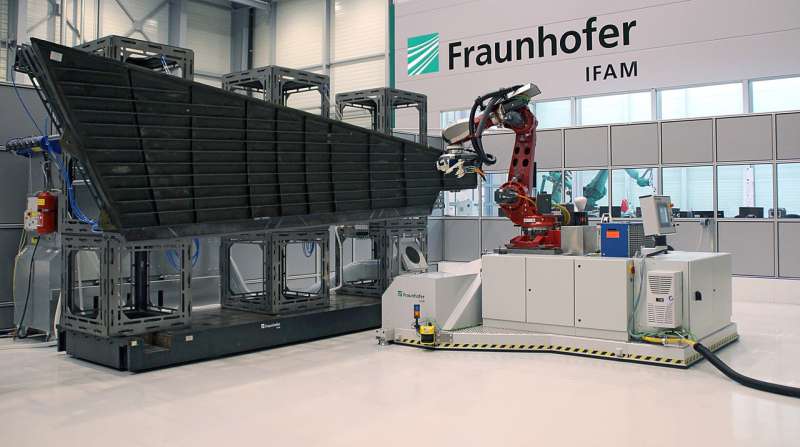All-purpose talent in aircraft manufacturing

In aircraft manufacturing, much of the milling, drilling and assembly is still done by hand. This is because the raw components vary not only in size and design, but also in shape accuracy. Small differences are unavoidable in extremely lightweight and elastic materials, which poses a challenge for automated processing. Working with an industrial consortium, Fraunhofer researchers have now developed a mobile robot that is able to handle these high requirements – the only robot in the world with this capability.
When automated machines are used in aircraft manufacturing today, they tend to be heavy, customized portal systems that slide slowly over the components on rails. However, as well as being expensive and inflexible, these systems stand idle for long periods, meaning their productivity levels are low.
"Our new robot is able to travel to the components autonomously and carry out all the requisite tasks there. Measuring, bonding, drilling, milling – it can do it all. The robot is an all-purpose machine and can be adapted quickly and flexibly to shape inaccuracies of large components as well as product and model modifications," says Dr. Dirk Niermann, Head of the Automation and Production Technology department at the Fraunhofer Institute for Manufacturing Technology and Advanced Materials IFAM in Stade. Whereas earlier robots have failed when it came to the high precision requirements in the aviation sector, the new robot has no such difficulties: the deviations in its machining results are less than half a millimeter.
Accuracy gains thanks to output-side measurement systems
"Above all, by integrating specially developed output-side measurement systems (so-called secondary encoders), we managed to substantially minimize error," explains Christian Böhlmann, Group Manager for Integrated Production Systems. While the measurement technology is attached to the engine in conventional industrial robots, it is fitted directly to the axles of the new robot. "This way, we always know the exact position of the axles." Other technologies also helped increase processing accuracy, including the control-side compensation of frictional adherence effects from the gears, and a refined calibration of the robot, by means of which one-off measurements are carried out to determine the true robot geometry, which is then factored into calculations of motion.
Because aviation components are often up to 20 meters in length, mobility was important when designing the new robot. "We developed a rigid platform with three drive wheels for the robot," says Böhlmann. "This means it can move freely around the factory floor and go wherever it is needed at a given time. As soon as it reaches its destination, it draws in its wheels and stands in a stable position."
In this way, the robot and other modular robotic production systems from Fraunhofer IFAM facilitate fluid, versatile manufacturing; they no longer pass through rigidly determined stations, but adapt quickly, flexibly and cost effectively to different requirements.
Provided by Fraunhofer-Gesellschaft



















